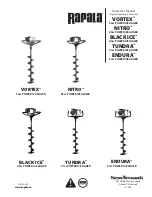
O
PERATOR
’
S
M
ANUAL
WRXi-OM-E Rev C
135
Waveform Sparser Setup
1. In the menu bar, touch
Math
, then
2. Touch the tab for the function (F1
loaded on your oscilloscope. See
3. Touch
inside
the
Source1
field and select an input waveform.
4. Touch
inside
the
Operator1
field and select
Sparse
from the
Select Math Operator
menu.
5. Touch
inside
the
Sparsing facto
nd enter a value, using the pop-up keypad.
6. Touch
inside
the
Sparsing offset
field and enter a value, using the pop-up keypad.
Interpolation
Linear interpolation, which inserts a straight line between sample point, is best used to reconstruct straight-edged
signals such as square waves. (Sinx)/x interpolation, on the other hand, is suitable for reconstructing curved or
irregular waveshapes, especially when the sampling rate is 3 to 5 times the system bandwidth. The instrument
also gives you a choice of Cubic interpolation.
For each method, you can select a fa
Interpolation Setup
1. In the menu bar, touch
Math
, then
Math setup...
in the drop-down menu.
2. Touch the tab for the function (F1 to Fx The number of math traces available depends on the software options
loaded on your oscilloscope. See Specifications.) you want to assign the Interpolate operation to.
3. Touch
inside
the
Source1
field and select an input waveform.
4. Touch
inside
the
Operator1
field, then touch the
Filter
button in the
Select Math Operator
menu.
5. Select
Interpolate
from the Filter
6. Touch the Interpolate
tab
in the m
7. Touch
inside
the
Algorithm
field
8. Touch
inside
the
Upsample by
Upsampling is the factor by which sampling is increased. field and enter a
value, using the pop-up numeric keypad, if you want to enter a specific value. Otherwise, use the
Up/Down
buttons to increment the displaye value in a 1-2-5 sequence.
FFT
Why Use FFT?
For a large class of signals, you can gain greater insight by looking at spectral representation rather than time
description. Signals encountered in the frequency response of amplifiers, oscillator phase noise and those in
mechanical vibration analysis, for example, are easier to observe in the frequency domain.
If sampling i
h
s
s
S
l
c
o
)
th
A
oint time domain signal can be compared to passing the signal through a comb filter
consisting of a bank of N/2 filters. All the filters have the same shape and width and are centered at N/2 discrete
frequencies. Each filter collects the signal energy that falls into the immediate neighborhood of its center
frequency. Thus it can be said that there are N/2 frequency bins. The distance in Hz between the center
frequencies of two neighboring bins is always the same: Delta f.
Math setup...
in the drop-down menu.
to Fx The number of math traces available depends on the software options
specifications.) you want to assign the Sparse operation to.
r
field a
ctor from 2 to 50 points by which to interpolate (upsample).
submenu.
ini setup dialog to the right of the main dialog.
and select an interpolation type.
d
s done at a rate fast enough to faithfully approximate the original waveform (usually five times the
ighest frequency component in the signal), the resulting discrete data series will uniquely describe the analog
ignal. This is of particular value when dealing with transient signals because, unlike FFT, conventional swept
pectrum analyzers cannot handle them.
pectral analysis theory assumes that the signal for transformation is of infinite duration. Since no physical signa
an meet this condition, a useful assumption for reconciling theory and practice is to view the signal as consisting
f an infinite series of replicas of itself. These replicas are multiplied by a rectangular window (the display grid
at is zero outside of the observation grid.
n FFT operation on an N-p
















































